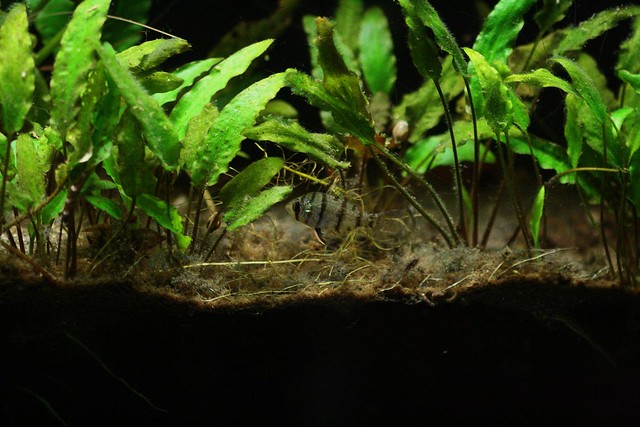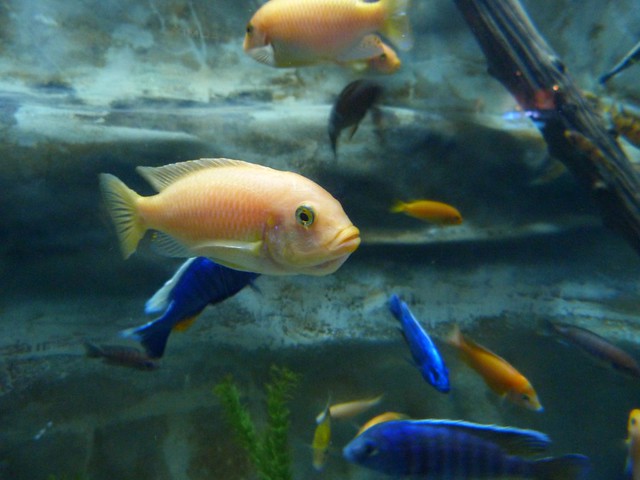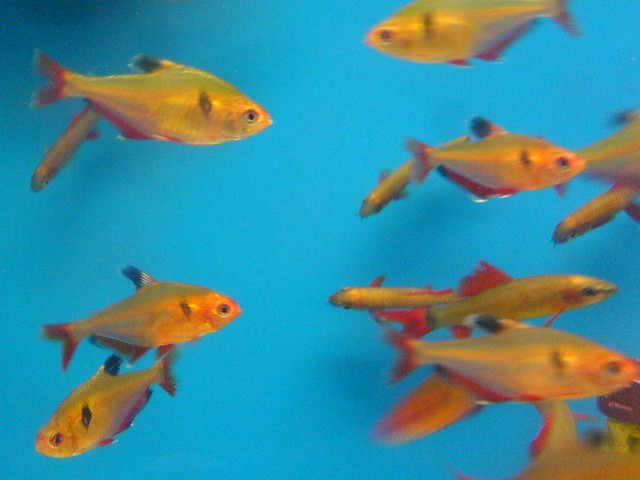 |
| Red nesaea - Ammannia gracillis |
2018-11-06
2018-11-05
Maintaining LIVE AQUARIUM PLANTS
 |
| Photo by scott361 |
Plants need Carbon Dioxide to grow.
Carbon dioxide (CO2) is the most important nutrient that you need to keep aquarium plants healthy. CO2 is produced by the waste products within the fish tank, like fish excrement, excess food and as a by-product of bacterial action but this is often not sufficient to keep plants in good condition.
Therefore many people utilize a system that puts CO2 into the aquarium. CO2 systems come in a variety of shapes and sizes but can be split into two simple types. Those that provide a constant source of CO2 and those that can regulate the CO2.
It is a good idea to regulate the CO2 either using the system or manually because fish will suffer if there is too much CO2 in the water. Rough guides for carbon dioxide suggest that 30 to 45 mg per liter of water is enough for plants to thrive but over 100mg per liter is too much for fish.
Plants need an adequate lighting source.
CO2 systems must be synchronized with the lighting system that you use in the aquarium. Light is a vital part of the photosynthesis process which plants use to turn light energy into chemical energy that they use to grow. Normally plants would derive the light source from the sun but in the case of aquarium plants, the sun may not be available so an artificial source is needed. The light source should provide a full spectrum of light to the plants. Popular types are mercury vapor or metal halide lights
Plants need a good substrate.
A substrate is the type of gravel or sand that you use in the fish tank. The substrate must be deep enough to allow the roots of plants to take hold and keep the plant firmly attached. You want the substrate to have a depth of about 8 cm.
Substrates can also be nutrient rich so they can help to keep the plants healthy but they must not alter the quality of the water. For example, lime based substrates will make the water harder or more alkaline. Most fish have a preference for soft or hard water if the water was to change due to the substrate the fish could become stressed or ill.
Many Aquarists use layers of a substrate to get around this problem. If a fish likes soft water then the top layer of the substrate would be a lime-free gravel. Under the lime-free gravel, a liner layer of nutrient-rich gravel could be used.
Summary.
Carbon dioxide, a good light source and a nutrient rich substrate are important components in maintaining live aquarium plants. Liquid fertilizers can also be used if you feel that the plants look in poor condition.
|
2018-11-03
AERATION: - essential factor to aquarium fish.
As we all know rivers and lakes are the natural habits for fish and other marines. Rivers and lakes have a large surface area which makes maximum provision of oxygen for fish survival possible. On the other hand, the aquarium is not like a river or lake, it has a smaller surface area and there is a limited movement of habitats.
This makes provision of alternative means of oxygen for fish to breathe importantly. This artificial process of providing oxygen is called aeration. It's a simple process of re-oxygenating the water in the aquarium tank.
The Aerating System:
This is the series of material that increases the supply of air (thereby increasing oxygen concentration) they are:
- the air pump
- t-pieces
- rubber tubing
- clamp or regulator
- diffusers or airstone
Air pumps come in different shapes and sizes but the most popular ones are tecax air pump from Taiwan together with 'Dyna free, and the dragon' another popular one is super 555 from India though cheaper, but not as rugged. Occasionally available are the more expensive whisper and rens air pumps from Uk and rance respectively. Always place air pumps above the water level hooked to a non-vibrating material.
You can accomplish aeration in your aquarium tank by using the above-listed aeration materials. This materials form the aeration system. For small tanks, all you need is to attach simple aquarium air pump to airstone by means of rubber air tube. The system will be blowing air into the water which causes motion in the aquarium tank and thus provide necessary oxygen your fish needs to breathe in the aquarium.
2018-11-01
Mouth Brooding AFRICAN CICHLIDS
 |
| Photo by Rusty Clark – hottnfunkyradio.com |
Most African Cichlids are what's called "maternal mouthbrooders." Mouthbrooders are highly advanced from an evolutionary standpoint. They've developed a technique for protecting their young along at the most vulnerable time in their development. Mouthbrooders brood their eggs within their mouths!
For many of the non-mouthbrooding cichlids, and that is most neotropical cichlids, more or less stable pairs are formed and maintained through pair-bonding behaviors. Such behaviors as jaw locking, gill flaring (frontal displays) and beating/circling (lateral displays) function permitting inspection and "testing" of potential mates. This behavior will continue, following the establishment of any pair bond, as a ritualistic recognition or greeting behavior reaffirming that bond.
There isn't any best or right setup and design for cichlids. You can find however designs which may be better suited to your cichlids and make them feel more at home. If you're interested in seeing natural behaviors from the fish you should try to design your aquascape to mirror the environment your fish would live in if it were wild.
Not every setup will work with every cichlid. One example is an exceptionally rocky African Mbuna setup will not make a South American or even an African hap very happy. Many individuals who keep fish think cichlids are difficult to take care of, but Cichlids are easy to maintain once you learn how to keep them healthy and stress-free. 90% of issues with cichlids start with stress, tank mates, pH levels, and feeding them the wrong food.
To acquire more information about the technicalities of keeping cichlids, read Cichlid Fish Secrets. It's very professionally written and very easy to read whatever experience level, which is loaded from start to finish with relevant, detailed, and simple reading information.
|
2018-10-30
Characteristics Of The SERPAE TETRA Fish
 |
| Photo by dmott9 |
Originally from South America, Peru and the Amazon River basin, the serpae tetra fish is sleek, tall and compressed. A serpae tetra fish typically grows up to 2.2 inches long. The female serpae tetra fish is generally a bit more rounded than its male counterpart. The color of the serpae tetra fish's body can range from bright red to reddish brown. The serpae tetra fish's ventral and anal fins are red. Its dorsal fin, however, is black with white fringing. A black spot can be found behind its gill cover. As the serpae tetra fish ages, this black spot slowly become smaller.
If you are thinking of getting serpae tetras, make sure that your aquarium is well planted. Serpae tetras love live plants and driftwoods. While the serpae tetra fish can tolerate being in an aquarium with low temperatures, it is best that you keep the temperature between 68 and 82 degrees Fahrenheit to keep your serpae tetra fish happy.
The serpae tetra fish is an easy fish to care for and to feed. A serpae tetra fish will eat everything from flakes to live, freeze-dried and frozen foods. Give your serpae tetra a variety of diet. If you have several serpae tetras, you will notice that they will nip at each other's fins while you feed them in an effort to grab for food.
Serpae tetras are community fish. However, it is recommended that you do not mix your serpae tetra fish with neon tetra fish because serpae tetra fish can be a bit too aggressive for the neon tetra fish to handle.
You will typically find serpae tetras swimming in the middle and bottom areas of the aquarium tank. In general, serpae tetras do not bother other fish in the tank. However, serpae tetras love to play with and chase each other around the tank.
|
2018-10-29
Pet JELLYFISH Facts: Moon Jellies (Aurelia Aurita)
 |
| A Moon Jellyfish. (Photo credit: Wikipedia) |
Moon jellies are the easiest jellyfish to keep alive in captivity. This is because of their diversity in nature. Moon jellies can be found in almost every ocean in the world. Their natural habitat stretches from the equator as far north as 70 latitudes and as far south as 40 in every ocean that falls within those geographic parameters.
They are prominent in the shallow coastal waters of estuaries and harbors which explains their abundance in what is still an infant branch within the larger saltwater aquarium trade industry. Because they are common in both temperate and tropical water, they can tolerate temperature ranges anywhere between 42-88 F (6-31 C). Although they can survive in brackish water, a salinity level (specific gravity) of 1.023 will mimic their native marine environment.
The name moon jellyfish is purely descriptive. They are named for the most prominent part of their anatomical makeup, their large disk or full moon shaped bell. They can be further distinguished by the four horseshoe-shaped gonads at the center of their bell. These reproductive organs resemble the craters found on the moon. These fish are very popular as pets because they are transparent and will appear to glow in whatever color is shined through them. They look particularly stunning in an aquarium with an LED fader system set up in it.
Another point in their favor is that their stinging cells do not produce enough pressure to pierce human skin. In the wild, a moon jelly's life cycle is limited to one year from start to finish. In captivity, they can easily live up to three years. These jellies can grow up to one foot in diameter.
Another point in their favor is that their stinging cells do not produce enough pressure to pierce human skin. In the wild, a moon jelly's life cycle is limited to one year from start to finish. In captivity, they can easily live up to three years. These jellies can grow up to one foot in diameter.
In nature, moon jellies spend most of their time drifting on currents rather than swimming. In captivity, they will require an aquarium with a well-designed turbulence system to keep them from becoming a helpless ball of gelatinous goo at the bottom of your tank.
There are currently two retailers in the United States that sell moon jellies. Although moon jellyfish can tolerate a wide temperature range, 77 F is most conducive to their adult phase of life. Moon jellies typically arrive ranging from 2-4 inches in diameter. Their growth rate and maximum disc size are proportional to their caloric intake. This means that they may never grow to their maximum disc size of 12 inches in an aquarium. You can, in fact, prevent them from doing so if you wish to keep them in a smaller aquarium. Depending on their size, moon jellies can be fed brine shrimp, feeder shrimp or feeder fish. There is also commercially available frozen jellyfish food created from zooplankton. This frozen preparation will provide them with all the nutrients they need to keep them alive and healthy.
Moon jellies look absolutely amazing with an array of fading LEDs shining through them. You can now buy a Jellyfish Fish Tank Aquarium to raise your own pet jellyfish in. You can even light them up just like they are in the big public aquarium jellyfish exhibits.
Moon jellies are by far the most easily obtainable jellyfish on the market. Moon jellyfish are even being tank raised to supply the rising demand of home aquarium owners. Learn more about Moon Jellyfish and other Pet Jellies.
|
2018-10-27
Subscribe to:
Posts (Atom)


